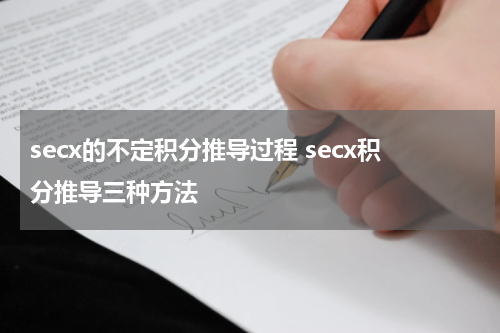Thereareseveralmethodstoderivetheindefiniteintegralofsec(x).Herearethreecommonmethods:Method1:Usingtheidentitysec^2(x)=1+tan^2(x)1.Rewritetheintegralas:∫sec(x)dx2.Multiplyanddivideby(sec(x)+tan(x)):∫s

There are several methods to derive the indefinite integral of sec(x). Here are three common methods:
Method 1: Using the identity sec^2(x) = 1 + tan^2(x)
1. Rewrite the integral as:
∫ sec(x) dx
2. Multiply and divide by (sec(x) + tan(x)):
∫ sec(x) * (sec(x) + tan(x)) / (sec(x) + tan(x)) dx
3. Simplify the integrand:
∫ (sec^2(x) + sec(x)tan(x)) / (sec(x) + tan(x)) dx
4. Use the identity sec^2(x) = 1 + tan^2(x) to rewrite the integrand:
∫ (1 + tan^2(x) + sec(x)tan(x)) / (sec(x) + tan(x)) dx
5. Split the integrand into two separate fractions:
∫ (1 + tan^2(x))/(sec(x) + tan(x)) dx + ∫ sec(x)tan(x) / (sec(x) + tan(x)) dx
6. Simplify each fraction:
∫ (1 + tan^2(x))/(sec(x) + tan(x)) dx = ∫ dx = x + C (where C is the constant of integration)
∫ sec(x)tan(x) / (sec(x) + tan(x)) dx can be simplified using the substitution method or by using the identity tan(x) = sin(x)/cos(x).
Method 2: Using the substitution method
1. Let u = tan(x), so du = sec^2(x) dx.
2. Rewrite the integral in terms of u:
∫ du/u
3. Evaluate the integral:
ln|u| + C
4. Substitute back for u:
ln|tan(x)| + C (where C is the constant of integration)
Method 3: Using the complex exponential function e^ix.
1. Rewrite sec(x) as 1/cos(x).
2. Use the Euler's formula: e^(ix) = cos(x) + i*sin(x), where i is the imaginary unit.
3. Rewrite 1/cos(x) as 1/(0.5*(e^(ix)+e^(-ix))).
4. Multiply the numerator and denominator by e^(ix) to clear the denominator:
∫ e^(ix)/(0.5*(e^(ix)+e^(-ix))) dx
5. Simplify the integrand:
∫ 2e^(ix)/(e^(ix)+e^(-ix)) dx
6. Perform the substitution u = e^(ix)+e^(-ix):
∫ 2du/u
7. Evaluate the integral:
2ln|u| + C
8. Substitute back for u:
2ln|e^(ix)+e^(-ix)| + C
9. Simplify using trigonometric identities:
2ln|2cos(x)| + C = ln|4cos(x)| + C (where C is the constant of integration)
